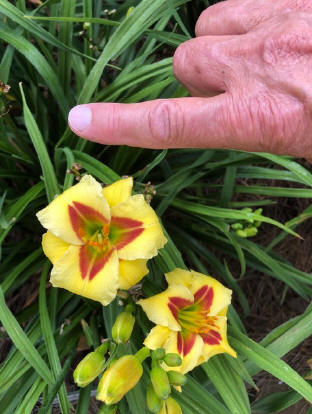Charlie Gomer
Adams County Master Gardener
 (6/15) According to the most recent statistics from the Department of Agriculture census, daylilies are the second most valuable perennial in sales right after hostas. The hosta is a shade-loving plant as compared to daylilies that like six or more hours of sun
daily. The real name of a daylily, although seldom used, is hemerocallis. This term is derived from the Greek word hemera meaning "a day" and kallos, meaning "beauty"; therefore, beauty for a day. Rather misleading because even though the bloom of a daylily lasts only for one day, most daylilies have many buds on their scapes (stems) and actually bloom for several weeks.
(6/15) According to the most recent statistics from the Department of Agriculture census, daylilies are the second most valuable perennial in sales right after hostas. The hosta is a shade-loving plant as compared to daylilies that like six or more hours of sun
daily. The real name of a daylily, although seldom used, is hemerocallis. This term is derived from the Greek word hemera meaning "a day" and kallos, meaning "beauty"; therefore, beauty for a day. Rather misleading because even though the bloom of a daylily lasts only for one day, most daylilies have many buds on their scapes (stems) and actually bloom for several weeks.
Many people are unaware of the wide variety of daylilies that are now available. They usually think of the roadside orange lilies that bloom for a few days each year or the common yellow lilies used commercially or in parking lots. Garden centers and large box stores carry old-fashioned daylilies that have been around for years as compared to what
is really available.
If you’re working on designing your gardens, please consider adding modern daylilies to the mix. There is more variety in the height of the flower from twelve inches to over six feet. The size of the actual flower bloom has a range from under three and one half inches to over twelve inches. The bloom is the most interesting feature of the plant,
and the variety of forms is outstanding: single, double, unusual form, spider and sculpted. There are over 75,000 different registered daylilies recorded with the American Hemerocallis Society AKA the American Daylily Society.

Hybridizers, mostly small time gardeners, who have become interested in developing new and better daylilies of different colors, sizes, and shapes, begin by observing their new seedling daylilies for several years from the varieties that they have crossed. They will only register plants with the American Daylily Society that are unique and have
good or improved plant qualities. The organization then keeps a database of records of the various daylilies. Anyone can look up a daylily or cultivar and see a photograph and the specifics about that particular daylily. Next hybridizers will introduce their plant to members of the American Daylily Society and the public. Most people will never see these newer plants as
they are not available in most garden centers and are of very limited supply. The daylilies you see at the big box stores and garden centers are older varieties that have been commercially grown.
If you’re interested in seeing some of the wonderful new and current varieties, you can go to the American Daylily Society website (https://daylilies.org/) and look for display gardens in our local area, Region 3, where you will find members with recognized display gardens in Adams, Franklin, and York Counties and the contact information to make an
appointment. Visit and see some of the exciting new daylilies. Also be aware that most display gardens have plants for sale. Our garden Gettysburg Daylilies and Peafowl, located on the outskirts of Gettysburg, is a display garden with over 1,100 different registered daylilies. Our peak bloom season is the last week in June through the first two weeks in July.
Read: Daylilies - the perfect perennial